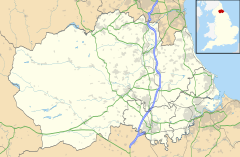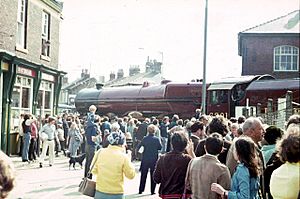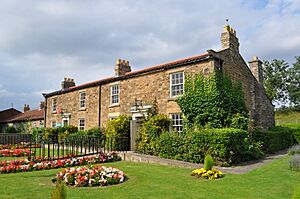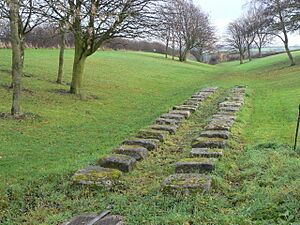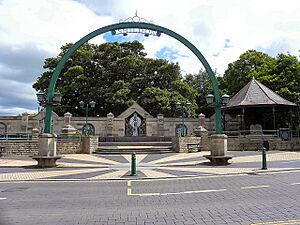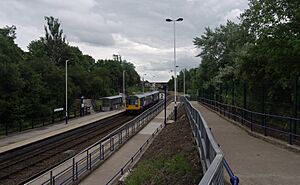Shildon facts for kids
Quick facts for kids Shildon |
|
|---|---|
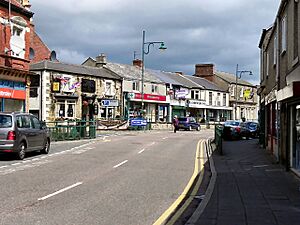 Church Street |
|
| Population | 9,976 (2011 Census) |
| OS grid reference | NZ226263 |
| • London | 225 mi (362 km) |
| Civil parish |
|
| Unitary authority |
|
| Ceremonial county | |
| Region | |
| Country | England |
| Sovereign state | United Kingdom |
| Post town | SHILDON |
| Postcode district | DL4 |
| Dialling code | 01388 |
| Police | Durham |
| Fire | County Durham and Darlington |
| Ambulance | North East |
| EU Parliament | North East England |
| UK Parliament |
|
| Website | https://shildon.gov.uk |
Shildon is a town and civil parish in County Durham, England. In 2011, about 9,976 people lived there. Shildon is famous for its railway history. It has the Locomotion Museum because it was home to the first railway station, built in 1825. The town also had important workshops for the Stockton and Darlington Railway.
Contents
Shildon's Past
Shildon has a long history, with the first people living here about 6,000 years ago. These early settlers were hunter-gatherers. They found food by collecting wild plants and hunting animals. A small stone tool found in the Brusselton area might be from this time.
Roman Times
The Romans arrived in County Durham in the 1st century AD. They built forts along a Roman road that went north towards Hadrian's Wall. You can still find traces of these Roman roads in places like Brusselton Wood in Shildon. Small villages grew up along these roads.
Early Villages
By the end of the Anglo-Saxon period, Shildon was a small village. Several medieval settlements were also located around an area called Thickley.
Industrial Growth
Shildon grew a lot because of the coal mines in East Durham. This happened during the Industrial Revolution in the late 1700s and early 1800s.
Railway History
As coal mining grew, the old way of moving coal with horse-drawn wagons was too slow. So, steam engines were introduced. At first, engines stayed in one place and pulled wagons. But soon, moving engines on railways took over.
Shildon is often called the "cradle of the railways." The town grew quickly when the Stockton and Darlington Railway opened its workshops in 1825. Famous steam locomotives like the Sans Pareil and Royal George were built there. The town's population grew to about 9,000 people. By 1855, the railway workshops were a huge complex. After the Second World War, Shildon had one of Europe's biggest railway sidings.
The Shildon Works closed in 1984. Today, the site is home to the Locomotion Museum. This museum opened in 2004 and is part of the National Railway Museum.
George Stephenson built a railway track from Witton Park to Stockton-on-Tees. At first, static engines pulled coal wagons over Brusselton. After that, they were connected to steam engines. You can still see the remains of a static engine house at Brusselton. The railway first carried only coal. But soon, people wanted to travel too. The very first passenger train started its journey in Shildon on September 27, 1825.
Shildon was also the home of Timothy Hackworth. He was a railway inventor and built one of the first engines, the Sans Pareil. Daniel Adamson, another important engineer, was born here too. He was Hackworth's apprentice.
Today, Shildon railway station serves the town and the Locomotion Museum. It is on the Tees Valley Line.
Shildon in the 19th Century
At the start of the 1800s, Shildon was just a few houses at a crossroads. The Industrial Revolution and the arrival of railways made the town grow. In 1801, only 100 people lived there. They worked in farming, coal mining, and the growing textile industry.
The amount of coal being mined became too much for horse-drawn wagons. So, steam power was used. First, stationary steam engines pulled coal. Then, steam locomotives took over. Coal wagons were pulled by static engines over Brusselton Incline into Shildon. There, they would be attached to a locomotive.
The town's population grew rapidly. It went from 115 people in 1821 to 2,631 in 1841. By the end of the century, it was 11,759.
Because people wanted to travel, a passenger service started from Shildon on September 27, 1825. The first train, Locomotion No.1, began its journey outside the Mason's Arms pub. Some people believe the Mason's Arms was the world's first railway station. In the early days, tickets were sold at the bar!
Engine Works
Timothy Hackworth moved into Hackworth House in 1831. This building is now called Soho House and is a Grade II* listed building. There, he oversaw the building of the Soho Engine Works nearby. In 1833, Hackworth took over the works himself, creating the Soho Locomotive Building Company.
The oldest part still standing is the Soho Shed. This Grade II* listed building was built in 1826 as a warehouse. Later, it became a paint shop for trains. In the 20th century, it was used as a boxing gym and a rehearsal space. The shed still has two engine pits and parts of an old heating system. It was restored in 1975.
Near the Soho Shed are the Grade II* listed coal drops. These were built around 1846 or 1856. They were used to refuel locomotive tenders. Coal wagons were pulled to the top of the drops. Their bottoms would open, and the coal would fall into the engine waiting below. Hackworth House, the engine shed, and the coal drops were all given a higher heritage status in 2021.
The Soho Works built the first locomotive to run in Nova Scotia, Canada. This engine, named Samson, was sent from Shildon in 1838 to move coal.
The Stockton and Darlington Railway expanded its works near the Mason's Arms Crossing. This expansion, along with the Soho works, caused the population to grow. More people came to Shildon for work. The growth sped up even more when Shildon Colliery opened in 1873.
In 1855, the Stockton and Darlington Railway bought the Soho Works. In 1863, these works merged with the North Eastern Railway. Locomotive building moved to Darlington, but the Shildon Works continued to build railway wagons.
Shildon in the 20th Century
In 1911, a strike in the town led to some unrest. The army was called in to help keep order.
By 1976, the Shildon Works became the largest wagon works in the world. It employed 2,600 people and built 1,000 wagons each year. Shildon was also home to what was thought to be the largest railway sidings in the world.
The Soho works were left empty after the 1940s and were planned to be torn down in the 1970s. However, they were saved and restored. They opened to the public as part of the Timothy Hackworth Museum. The museum was opened by Queen Elizabeth The Queen Mother in 1975.
Railway Works Closure
The railway works closed on June 29, 1984. This meant 1,750 people lost their jobs. A new industrial park was opened on the site in 1985 to help the town recover.
Daniel Adamson's Coach House
Shildon is also home to Daniel Adamson's Coach House, built around 1831. Daniel Adamson, who owned the Grey Horse pub, had a horse-drawn railway coach called Perseverance. It ran between Shildon and Darlington. When the Surtees Railway opened, Adamson built this coach house. It was used as both a station and a shed. It is believed to be the oldest surviving railway coach house in the world. His son, also named Daniel Adamson, became a famous engineer.
Brusselton Incline
On the edge of Shildon is a small village called Brusselton. Two hills made it hard to get coal from the mines to the railway in Shildon. George Stephenson solved this by putting stationary steam engines on the hilltops. These engines pulled the coal wagons over the hills. At the top of the Brusselton incline, two powerful engines pulled wagons up the slope. A large drum with a rope pulled the wagons over the incline to the locomotive waiting in Shildon.
The engineman's house on the south side of the road is still there. A passenger service also started over the incline in 1833.
The enginemen knew when wagons were ready to come up the hill by looking at a spinning disc on a tall pole. This is thought to be the world's first railway signalling system. If it was foggy, long wires with bells were used instead.
There were worries about wagons rolling away if the rope broke. So, young boys were hired to run alongside the track. If a wagon started to roll away, they would jump on and apply the brake. At the bottom of the incline, men would throw tree trunks onto the line to stop runaway wagons in an emergency.
The Shildon Tunnel was started in 1839 and opened in 1842. It cost a lot of money to build. Once the tunnel was finished, the Brusselton incline was no longer needed for the main railway line.
Volunteers are now working to uncover the old railway parts still at the Brusselton Incline site. They have found many stone sleepers, which were used to support the rails.
Locomotion Museum
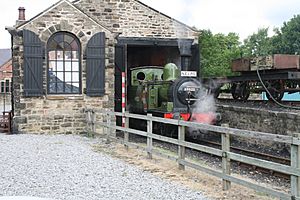
The Locomotion Museum opened on October 22, 2004. It includes the old Timothy Hackworth Museum and is part of the National Railway Museum in York. The Prime Minister at the time, Tony Blair, opened the museum.
The new museum was built with government funding. It also received money from other groups. The museum hoped to have 60,000 visitors in its first year. But it had 70,000 visitors in just the first two months! Shildon was chosen for the museum over other cities like Cardiff and Glasgow.
In January 2018, the museum welcomed its 2,500,000th visitor.
Education
- St. Johns C of E (Aided) Primary School
- Greenfield Academy
- Thornhill Primary School
- Timothy Hackworth Primary School
Community and Green Spaces
The Shildon Town Band started in 1937.
Hackworth Park is a park in Shildon town centre. It is named after Timothy Hackworth. The park has a drinking fountain that celebrates one of his engine designs. There is also a statue of him in the park.
Town Square
Before the new Millennium, Shildon received £24 million to improve the town. This included £380,000 for a new town square. The square has a 6-foot statue of Timothy Hackworth.
Distances from Shildon
| Place | Distance | Direction | Why it's important |
|---|---|---|---|
| London | 225 miles (362 km) | South | Capital city |
| Stockton-on-Tees | 14 miles (23 km) | South east | Important for railway history |
| Durham | 10+1⁄2 miles (16.9 km) | North | Nearest city and historic county town |
| Darlington | 8 miles (13 km) | South east | Largest town in the county and important for railway history |
| Newton Aycliffe | 3 miles (4.8 km) | East | Next nearest town |
| Bishop Auckland | 2+1⁄2 miles (4.0 km) | North west | Next nearest town |
Sports
The local football club is Shildon A.F.C.. They play in the Ebac Northern League Division One. In 2003, the club reached the FA Cup first round for the first time in 42 years. They were successful in the 1930s, winning the Northern League three times.
Durham Tigers are the local rugby league team. They have teams for different age groups in the North East Junior League.
Shildon Running & Athletic Club was started in 1986. It is based at Stadium 2000 in Shildon.
Shildon Railway Cricket Club joined the NYSD premiere league in 2015. They won the 3rd division in their first try.
Transport
Train Travel
Shildon Station is a train station managed by Northern. It does not have staff. The signal box was built in 1887 and is a Grade II listed building. The station is on the Bishop Line, which runs between Bishop Auckland and Darlington. This line is a special "Community rail" line. The line continues from Darlington to Saltburn as the Tees Valley line.
Bus Travel
Bus services in Shildon are run by Arriva North East and Scarlet Band. These include services 5, 5A, X1, 1, and Weardale service 99.
Famous People from Shildon
- Timothy Hackworth, a famous railway engineer
- Daniel Adamson, another important railway engineer
- Sid Chaplin, a writer, who has the local library named after him
- Harry Beevers, a plant physiologist
- Thomas Ferens, a politician


